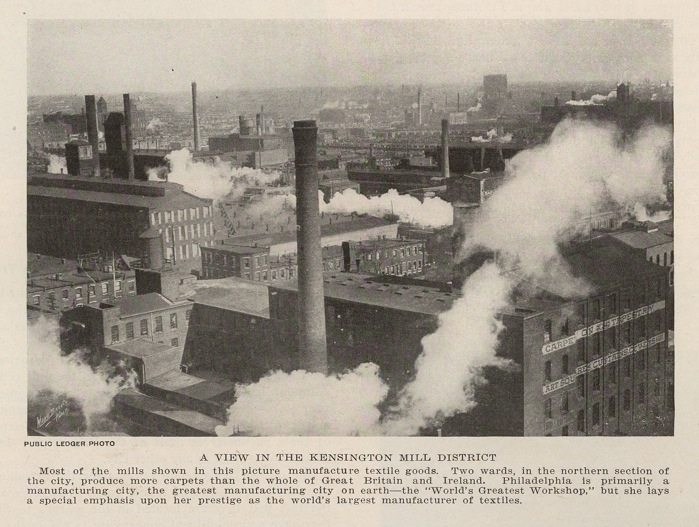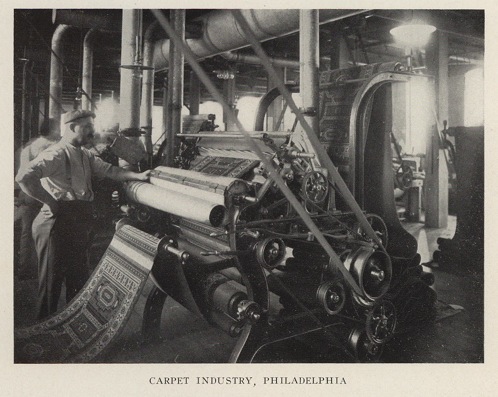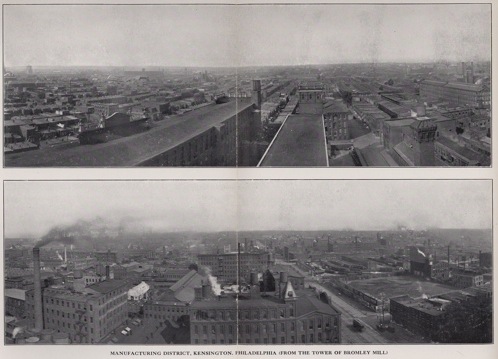
KENSINGTON
© Carmen A. Weber, Irving
Kosmin, and Muriel Kirkpatrick, Workshop of the World (Oliver
Evans Press, 1990).
As the area north and west of
Fishtown developed in the 1840s, the old neighborhood
name "Kensington" spread as well. Today, Kensington forms
an upside down, L-shaped neighborhood around Fishtown,
bounded by Erie Avenue on the north, 6th Street and
Germantown Avenue on the west, Girard Avenue on the
south, and Frankford Avenue, Norris Street, and Aramingo
Avenue on the east.
Traditionally, Kensington was known as the original hub
of working class Philadelphia, with both native and
immigrant workers living close to their work sites or
working at home. Early nineteenth century industry in the
area was diverse; it included glass factories and
potteries, wagon and machine works, and a chemical
factory. Many of the earlier sites were located in West
Kensington (west of Front Street), spreading north from
the Spring Garden District and Northern Liberties.
However, the textile trades came to dominate Kensington
by the mid-nineteenth century. The genesis of the ingrain
carpet industry was centered around Oxford and Howard
Streets in West Kensington, 1
where some mills
still stand. Other early carpet mills in this area are
now gone, but they included James Gay's Park Carpet Mill,
the Dornan Brothers' Monitor Carpet Mill, William J.
Hogg's Oxford Carpet Mill, the Stinson Brothers' Columbia
Carpet Mill, and the carpet mills of Horner Brothers, and
Ivins, Dietz, and Magee (later of Hardwick and Magee).
The earliest carpet factories operated mainly through
"outwork" the owners providing yarns to workers who hand
loomed the goods in their homes. As these small
textile concerns grew, their owners built small factories
in East Kensington. 2
Associated
textile trades, such as dye works, yarn factories, woolen
and worsted mills, 3
cotton mills, and
even textile machinery factories were often located in
the same building or complex. After the 1860s, Kensington
was filled with two story brick rowhouses and steam
powered mills. In 1883, Lorin Blodget described the
northward expansion of the area as having had rapid and
successful development from vacant fields a few years
ago, to a densely built up city, all of which is recent,
and most of it within ten or twelve years. It is
wellbuilt, with broad and well paved streets, the mills
being especially well located, and many of those recently
erected being fine specimens of architecture
4
Development of the neighborhood first spread along the
early roads, such as Germantown and Frankford Avenues,
and the canals created out of Cohocksink and Aramingo
Creeks; however, new growth was spurred by the railroads.
The Reading Railroad ran east to west from the coal
wharves in Richmond, with various coal yards located
along the line. The painted signs and small buildings
associated with these yards, such as the Smith and Boyd
and the Magee, are still visible along Lehigh Avenue,
east of Front Street. The Philadelphia and Trenton line
traveled in the center of Trenton Avenue to a station on
the edge of Fishtown, where neighborhood protest
prevented continuation of the line into Philadelphia. The
North Pennsylvania Railroad ran up American Street, where
numerous factories, and lumber and coal yards took
advantage of a rail connection. 5
Small firms comprised most of the textile industry in
Kensington in the nineteenth century. For example, in
1850, most of the district's 126 textile firms each had
only one owner and few employees on site.
6
At the same time,
one third of the firms and workers in textiles in
Philadelphia were in Kensington. 7
Irish, English,
Scotch, and German immigrants, as well as native workers
and owners lived in the neighborhood, although not always
harmoniously, as the nativist riots of the 1840s
indicated. 8
These 4,000 plus
workers maintained a tradition of handlooms into the
1880s. Handloom operators were predominately male,
with female workers often working in the power mills
tending looms as well as performing other service
tasks. 9
In addition to textiles, Kensington had a high percentage
of tanneries and leather-working industries.
Blodget, in 1883, listed 21 Morocco and calf-kid
factories in the 16th and 17th Wards, with a product
valued at $4 million. 10
These
leather-working industries were in the district until the
latter 1950s. Both the Drueding Brothers, at Master and
5th Streets, and Dungan and Hood, at Susquehanna Avenue
and American Street, were listed in the 1957 Chamber of
Commerce business firms directory; their buildings still
stand. Burk Brothers, mainly connected with the Northern
Liberties area, had a glazed kid factory at Hancock and
Turner Streets in 1891. In addition to leather-working
establishments, there were slaughter houses and meat
distribution centers in the area. Both Swift and Armour
had meat-packing plants along American Street and there
were poultry markets as well.

The diversity of
the textile trades in Kensington grew in volume
throughout the nineteenth century; however, the carpet
industry predominated. In 1882, 141 Kensington carpet
firms in the 19th and 31st Wards employed over 6,000
individuals and were valued at over $12 million.
11
The largest of
these firms, John Bromley and Sons, covered more than a
city block at 201-263 East Lehigh Avenue before it was
destroyed by a fire in 1971. As with many Kensington
firms, the Bromley mills had several Kensington locations
before construction of the large power mill on Lehigh
Avenue.

"From the tower
of the Bromley Mill at Fourth & Lehigh Avenue there
are more textile mills within the range of vision than
can be found in any other city in the world. For miles in
every direction is seen the smoke of thousands of mills
and factories. To the northeast one continuous line of
factories extends through Frankford to Tacony, six miles
away. To the northwest through the smoke rising from the
Midvale works at Nicetown the mills of Germantown are
seen. To the west another line of mills stretched to the
Falls of Schuylkill and Manyunk. To the southwest are
Baldwin's and the foundries and mills of that section. To
the south are the hat and leather factories and the the
southeast are Cramp's shipyard and the numberless
industries clustered along the river Beyond all these are
the mills and factories of South and West bPhiladelphia,
some of them eight miles away."—Manufacturing in
Philadelphia, 1683-1912
Hosiery and knitting mills became more and more common in
the late nineteenth and early twentieth centuries. By the
1920s, one third of Kensington's work force had shifted
from the carpet industry to employment in hosiery
mills. 12
These 11,000
workers produced all types of knit goods hosiery,
socks, fabrics, scarves, and sweaters. In 1928, 350 of
the city's 850 textile firms still operated in
Kensington, employing almost 35,000 workers. Of these
firms, 265 remained in 1940 after the Depression. During
World War II, some mills produced goods for the
government war effort, such as mosquito netting and
tarpaulins. The number of textile concerns shrunk to 75
in the late 1960s, and continues to shrink today. Most of
Kensington's mills stand abandoned and threatened by
deterioration and redevelopment. The creation of an
Enterprise Zone for redevelopment incentives on American
Street has meant the replacement of multistoried brick
building complexes with small, one story buildings. One
of the largest and most significant of Kensington's
factory complexes, the John B. Stetson Hat
Manufactory, no longer exists. Famous for their Western
hats, the Stetson Company made 3 million hats annually by
the 1920s. This complex, constructed between 1874 and
1930, included more than twenty buildings and over 30
acres of floor space. At its peak in the 1920s, more than
3,500 men and women worked at Stetson.
13
Stetson provided
a number of beneficial institutions for his employees,
including a hospital. All that remains of his domain is a
painted sign for the John B. Stetson Savings and Loan
Association on the corner of Germantown Avenue and
Montgomery Street. The plant closed in the 1960s.
14
1 Lorin Blodget,
Census
of Manufactures of Philadelphia (Philadelphia, 1883), p. 66.
2 Philip Scranton,
Proprietary
Capitalism: The Textile Manufacture at Philadelphia
1800-1885, (Philadelphia, 1983), p.
218.
3 According to the Oxford
English Dictionary, worsted originally referred to wool
made from "well-twisted" yarn, spun from long, staple
wool, combed to lay all the fibers parallel; it
eventually applied to fine and soft woolen yarn used
mainly for knitting and embroidery.
4 Blodget,
Census
of Manufactures of Philadelphia, p. 75-76.
5 T. Drayton, Plan of the
City of Philadelphia, (Philadelphia, 1830); and J. C.
Sidney, Map of the City of Philadelphia, (Philadelphia,
1849); and R. L. Barnes, Plan of the Built Portions of
the City of Philadelphia, (Philadelphia, 1855).
6 Scranton,
Proprietary
Capitalism, p. 189.
7 Scranton,
Proprietary
Capitalism, p. 182.
8 Scranton,
Proprietary
Capitalism, p. 187.
9 Scranton,
Proprietary
Capitalism, p. 193-194.
10 Blodget,
Census
of Manufactures of Philadelphia, p. 70, 73.
11 Blodget,
Census
of Manufactures of Philadelphia, p. 77.
12 Philip Scranton,
The
Philadelphia System of Textile Manufacture:
1884-1984 (Philadelphia, 1984), p. 16.
13 Federal Writers
Project, Works Progress Administration,
Philadelphia,
A Guide to the Nation's Birthplace
(Philadelphia
1937), p. 517.
14 Philip Scranton and
Walter Licht, Work
Sights, Industrial Philadelphia 1890-1950
(Philadelphia,
1986), p. 169.
Acknowledgements:
Special thanks to
Harold E. Spaulding, who provided in-depth research on
the history and present-day sites of Lower North
Philadelphia, which contributed to the chapter overview
as well as the survey of buildings.
Resources:
Kensington
bibliography